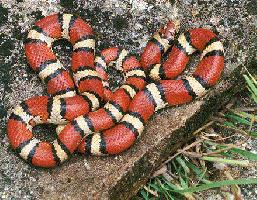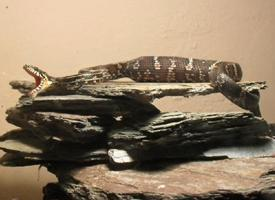
Weights and measures
| Length | from 50 to 60 cm |
|---|
Biological data
| Lifespan | 10 r |
|---|---|
| Length of gestation | from 3 to 4 m |
Animal description
The Smooth Snake (Coronella austriaca) is a fascinating reptile native to Europe and parts of Asia, distinguished by its non-venomous nature and relatively elusive behavior. This species belongs to the family Colubridae, which encompasses a wide range of snakes found across the globe. Characterized by its smooth scales, from which its common name is derived, the Smooth Snake typically exhibits a slender and graceful physique, measuring between 60 to 70 centimeters in length when fully grown, although some individuals may reach up to 80 centimeters.The coloration of the Smooth Snake is predominantly brown, gray, or reddish-brown, providing excellent camouflage against the forest floor and underbrush of its natural habitat. The dorsal side often features two dark stripes running parallel along the length of its body, interspersed with a row of darker spots or a zigzag pattern, which aids in further blending with the surroundings. The ventral side, in contrast, is usually lighter, ranging from creamy white to yellowish, with darker mottling or spots.
One of the most intriguing aspects of the Smooth Snake is its diet and hunting method. Primarily feeding on small mammals such as voles and mice, it also preys on lizards, birds, and occasionally, other smaller snakes. Unlike many other snake species, the Smooth Snake employs a unique hunting strategy. It is a constrictor, meaning it will capture its prey with its mouth and then coil its body around the prey item, squeezing tightly until the prey succumbs. This method is efficient and allows the snake to tackle prey items of various sizes.
Reproduction in Smooth Snakes is ovoviviparous, a fascinating aspect of their biology. Females give birth to live young, typically in late summer or early autumn, with litter sizes ranging from 5 to 15 offspring. This reproductive strategy is advantageous in cooler climates, as it allows the developing embryos to benefit from the mother's body heat, thus ensuring a higher survival rate in environments where temperature fluctuations can be extreme.
Smooth Snakes are diurnal, meaning they are most active during the day, especially in the morning and late afternoon when they bask in the sun to regulate their body temperature. Their habitats are diverse, spanning from dry, open areas to humid, dense forests. They show a particular preference for areas with abundant hiding spots, such as rock crevices, dense vegetation, and leaf litter, which offer protection from predators and ideal ambush sites for catching prey.
Despite their widespread distribution, Smooth Snakes are often considered elusive and are rarely encountered by humans due to their secretive nature and preference for undisturbed habitats. Unfortunately, like many wildlife species, they face threats from habitat destruction, pollution, and human encroachment, leading to declines in some populations. Consequently, they are protected under various conservation statutes across their range to preserve their numbers and habitats.
In summary, the Smooth Snake (Coronella austriaca) is a remarkable reptile with a distinctive appearance, interesting feeding habits, and a unique reproductive strategy. Its presence in the ecosystem is a testament to the adaptability and diversity of snakes, making it a species of interest for conservationists, herpetologists, and nature enthusiasts alike.
Similar Animals
New photos of animals
Top 10 animals
- Dolphin gull (Leucophaeus scoresbii)
- Diana monkey (Cercopithecus diana)
- Moustached guenon (Cercopithecus cephus)
- Galápagos tortoise (Geochelone nigra complex)
- Stone loach (Barbatula barbatula)
- Japanese macaque (Macaca fuscata)
- Greek tortoise (Testudo graeca)
- Russian tortoise (Testudo horsfieldii)
- Common flying dragon (Draco volans)
- Galápagos penguin (Spheniscus mendiculus)


